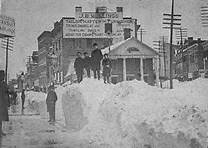
Forty Days in the Wilderness
And so…as the school year draws to its close and the frenzy of testing slows, (but does not yet completely abate), teachers and students dare to lift their heads from their high-stakes computer screens and look around them, through the settling assessment dust, up and down the corridors of learning.
And what do they see there? The halls still look pretty much the same. The bulletin boards are full of student work. The windows of the classroom doors are covered in case we have to go into lock down. Groups of students with their teachers move up and down the halls, some quietly, some less so, going to gym or library, art or music, or just to lunch. The school is back to normal.
Yet, as I sit with my groups of students who once again have their books out in front of them, who are reading, or discussing, or writing about something they’ve just read, I flip back through the pages of my lesson plan book, back through the months: May, April, March, February, January. I count up the times I have drawn a squiggly line down through the boxes that would normally hold notes for lessons. I count up the days I have written “testing” in orange highlighter to explain why these boxes are empty. Forty-two at this counting, forty-two, and the Smarter Balanced Make-Up Tests have not yet finished.
The Smarter Balanced Tests. We started in March with the third grade, did fifth grade in April, and just finished testing fourth at the end of May. There was Math and Language Arts and something called a performance task. I can’t remember anyone breaking down in tears (See Testing Testing One-Two-Three), but there were a lot of woebegone looks on little faces as one test day blurred into the next. There were also a lot of pleas for help which we had to reject. “No, honey, you have to try to do it yourself.” There were quite a few strangled moans of “This is haaaarrd.”
Some students took hours, even days to complete their tests. Others, when they realized they didn’t understand, just started clicking through. The heroes, to my mind, were the ones who gave it their best shot, who braved the computer screens crowded with print, and the curiously-worded questions, who struggled to type the answers, and when they were exhausted still went back to check.
How did our school do? I have no idea. Dare I say it? Right now, I don’t much care. Ask any test administrator and they will tell you: “The main thing is that it’s done.”
Test administrators. We met for months in whispered conversations in the hallways and stairwells, we chosen ones, clutching folders full of testing schedules and student names scribbled on sticky notes. We descended into the basement in the early mornings to make sure all the computers were on and had the right log in page up. We soothed the nerves of the classroom teachers as they brought their classes down to complete their testing. We told students not to worry.
Our over-riding concern; however, was purely technical: Getting and staying online. Getting back online after you got bumped off. Making sure the children logged in properly. Making sure they took the right test. Making sure their sound was on if they were one of the children who got the test read to them. Making sure they logged out correctly so their tests could be duly recorded. Frankly, caught in this fog of cutting-edge testing technology, we were hard put even to notice how the children were doing. All we wanted to be sure of was that they were doing it, answering the questions one way or another, so that at that great central testing station in the sky, they would know that we had DONE WHAT WE WERE SUPPOSED TO DO: we had tested all the children who needed to be tested in the window they needed to be tested in.
And now it’s pretty much over, thankfully, and we can all breathe a collective sigh of relief.
While out in the world, the battle continues to rage, the battle over high-stakes testing, whether it’s good, or bad, or even evil. I’ve read the stories about the mass student opt-outs in New York and New Jersey. I’ve read the arguments for better data, for accountability. But surely even the most dedicated advocate of high-stakes testing, the most hard-bitten devotee of enhanced data collection, the most enthusiastic supporter of all the new online testing platforms, cannot be in favor of forty-two days of no instruction.
Which brings us to a sad truth. You as a parent CAN decide to opt your child out of high-stakes testing, and in so doing you would indeed be removing them from the stress of these assessments, but you would not be removing them from the reality that now exists in many an American school: large parts of the regular school schedule grind to a halt until the many different mandated tests are complete. Your child may not have to take his or her tests, but he or she has to wait while the other kid takes his.
So we limp into June, into that hazy yet somehow also frantic period of field trips, field days, end-of-year concerts, and promotion ceremonies. The results of our pain and suffering have been collected and are somewhere being analyzed by a host of super computers and educational consultants. Long about August, I’m told, we’ll hear what they have to say. For the moment; however, it’s two months into a future I’m not sure I want to know about and I’m just glad to have some students sitting in front of me again. I’m glad my lesson plan book isn’t still full of blank spaces and squiggly orange lines. I’m glad that I don’t have to tell my students I can’t help them.
I’ve passed my forty days in the wilderness.
Next year there will forty more.





Linda,
This parent opted her son out of testing this year. It seems like the state of CT is starting to see the light, at least with high school juniors: http://www.courant.com/education/hc-house-supports-bill-to-that-eases-testing-for-juniors-bill-moves-now-to-the-governors-desk-20150602-story.html.
People just do not grasp the impact. Thanks for this excellent piece.
An exceptionally worded insight. Trying to make things “better”, they are only tying the hands of good(dare I say, great) teachers and making them feel ineffective. The time spent on testing decreases learning time, lower test scores, and so the circle begins.
Beautifully written, Linda, and utterly heartbreaking.